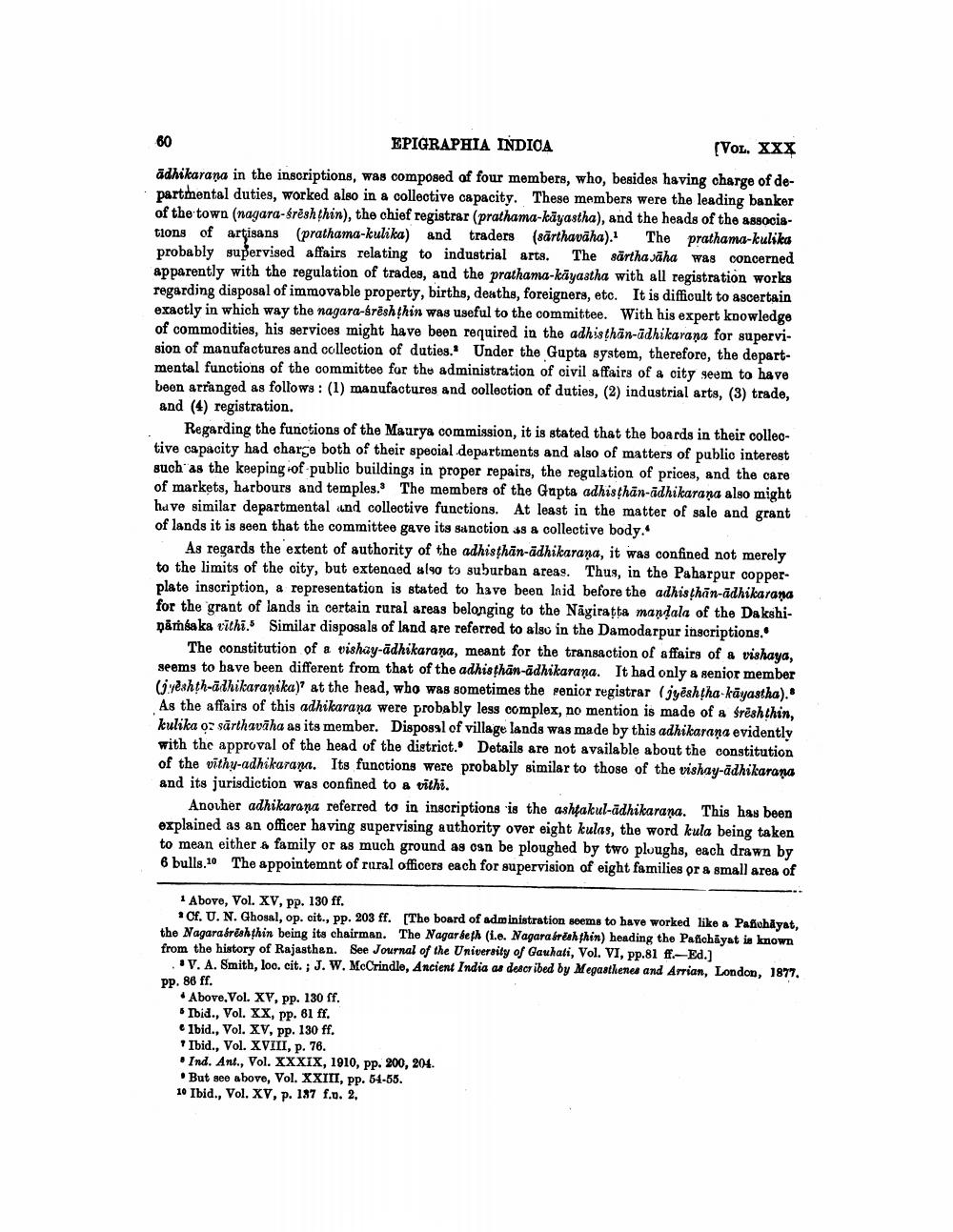________________
EPIGRAPHIA INDICA
(VOL. XXX adhikarana in the inscriptions, was composed of four members, who, besides having charge of departmental duties, worked also in a collective capacity. These members were the leading banker of the town (nagara-śrēshthin), the chief registrar (prathama-kāyastha), and the heads of the associations of artisans (prathama-kulika) and traders (sārthaväha). The prathama-kulika probably supervised affairs relating to industrial arts. The särtha Jāha was concerned apparently with the regulation of trades, and the prathama-kayastha with all registration works regarding disposal of immovable property, births, deaths, foreigners, etc. It is difficult to ascertain exactly in which way the nagara-srështhin was useful to the committee. With his expert knowledge of commodities, his services might have been required in the adhisthän-ūdhikarana for supervision of manufactures and collection of duties. Under the Gupta system, therefore, the departmental functions of the committee for the administration of civil affairs of a city seem to have been arranged as follows: (1) manufactures and collection of duties, (2) industrial arts, (3) trade, and (4) registration.
Regarding the functions of the Maurya commission, it is stated that the boards in their collective capacity had charge both of their special departments and also of matters of public interest such as the keeping of public buildings in proper repairs, the regulation of prices, and the care of markets, harbours and temples. The members of the Gupta adhisthan-adhikarana also might have similar departmental and collective functions. At least in the matter of sale and grant of lands it is seen that the committee gave its sanction $8 a collective body.
As regards the extent of authority of the adhisthan-ādhikarana, it was confined not merely to the limits of the city, but extenaed also to suburban areas. Thus, in the Paharpur copperplate inscription, a representation is stated to have been laid before the adhisthan-adhikarana for the grant of lands in certain rural areas belonging to the Nägiratta mandala of the Dakshipārba ka cithi. Similar digposals of land are referred to also in the Damodarpur inscriptions.
The constitution of a vishay-ādhikarana, meant for the transaction of affairs of a vishaya, seems to have been different from that of the adhisthan-ādhikarana. It had only & senior member
veshth-adhikaranika)' at the head, who was sometimes the senior registrar (jyështha-kayastha). As the affairs of this adhikarana were probably less complex, no mention is made of a freshthin, kulika oz sārthavīha as its member. Disposal of village lands was made by this adhikarana evidently with the approval of the head of the district." Details are not available about the constitution of the vithy-adhikarana. Its functions were probably similar to those of the vishay-adhikarana and its jurisdiction was confined to a vithi.
Another adhikarana referred to in inscriptions is the ashtakul-ūdhikarana. This has been explained as an officer having supervising authority over eight kulas, the word kula being taken to mean either a family or as much ground as can be ploughed by two ploughs, each drawn by 6 bulls.10 The appointemnt of rural officers each for supervision of eight families or a small area of
* Above, Vol. XV, pp. 130 ff.
1 Of. U. N. Ghosal, op. cit., pp. 203 ff. [The board of administration seems to have worked like a Pafchayat, the Nagara krēshthin being its chairman. The Nagar beth (i.e. Nagara fresh thin) heading the Pafichāyat is known from the history of Rajasthen. See Journal of the University of Gauhali, Vol. VI, pp.81 ff.-Ed.)
V. A. Smith, loc. cit.; J. W. McCrindle, Ancient India as described by Megasthenes and Arrian, London, 1877, Pp. 88 ff.
. Above, Vol. XV, pp. 130 ff.
Ibid., Vol. XX, pp. 81 ff. • Ibid., Vol. XV, pp. 130 ff. * Ibid., Vol. XVIII, p. 76. . Ind. Ant., Vol. XXXIX, 1910, pp. 200, 204.
But see above, Vol. XXIII, pp. 54-55. 10 Ibid., Vol. XV, p. 137 f... 2.




